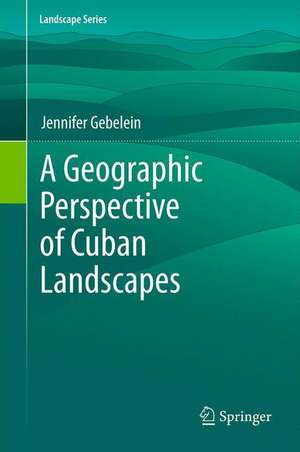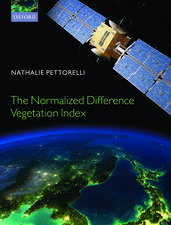A Geographic Perspective of Cuban Landscapes: Landscape Series, cartea 15
Autor Jennifer Gebeleinen Limba Engleză Hardback – 6 noi 2011
The author goes further to analyze the manner, speed and methods of landscape change, and examines the historical context and governing agendas that have had an impact on the relationship between Cuba’s inhabitants and their island. Gebelein also assesses the key role played by agricultural production in the framework of international trade required to sustain Cuba’s people and its economy. The book concludes with a review of current efforts by Cuban and other research scientists, as well as private investors, conservation managers and university professors who are involved in shaping Cuba’s evolving landscape and managing it during the country’s possible transition to a more politically diverse, enfranchised and open polity.
| Toate formatele și edițiile | Preț | Express |
|---|---|---|
| Paperback (1) | 768.86 lei 39-44 zile | |
| SPRINGER NETHERLANDS – 23 aug 2016 | 768.86 lei 39-44 zile | |
| Hardback (1) | 940.25 lei 6-8 săpt. | |
| SPRINGER NETHERLANDS – 6 noi 2011 | 940.25 lei 6-8 săpt. |
Din seria Landscape Series
- 24%
 Preț: 779.53 lei
Preț: 779.53 lei - 18%
 Preț: 1110.72 lei
Preț: 1110.72 lei - 24%
 Preț: 783.06 lei
Preț: 783.06 lei - 24%
 Preț: 670.12 lei
Preț: 670.12 lei -
 Preț: 459.09 lei
Preț: 459.09 lei - 23%
 Preț: 653.81 lei
Preț: 653.81 lei - 24%
 Preț: 719.87 lei
Preț: 719.87 lei - 20%
 Preț: 554.04 lei
Preț: 554.04 lei - 18%
 Preț: 1005.74 lei
Preț: 1005.74 lei - 18%
 Preț: 1664.61 lei
Preț: 1664.61 lei - 18%
 Preț: 1222.01 lei
Preț: 1222.01 lei -
 Preț: 381.81 lei
Preț: 381.81 lei - 18%
 Preț: 954.31 lei
Preț: 954.31 lei - 18%
 Preț: 1218.69 lei
Preț: 1218.69 lei - 18%
 Preț: 939.00 lei
Preț: 939.00 lei - 18%
 Preț: 1565.29 lei
Preț: 1565.29 lei - 15%
 Preț: 641.03 lei
Preț: 641.03 lei - 18%
 Preț: 947.04 lei
Preț: 947.04 lei - 18%
 Preț: 1393.72 lei
Preț: 1393.72 lei - 18%
 Preț: 744.36 lei
Preț: 744.36 lei - 15%
 Preț: 649.22 lei
Preț: 649.22 lei - 24%
 Preț: 688.56 lei
Preț: 688.56 lei - 19%
 Preț: 474.45 lei
Preț: 474.45 lei -
 Preț: 397.01 lei
Preț: 397.01 lei - 15%
 Preț: 636.63 lei
Preț: 636.63 lei - 18%
 Preț: 937.37 lei
Preț: 937.37 lei - 18%
 Preț: 1223.88 lei
Preț: 1223.88 lei
Preț: 940.25 lei
Preț vechi: 1146.65 lei
-18% Nou
Puncte Express: 1410
Preț estimativ în valută:
179.96€ • 187.17$ • 150.81£
179.96€ • 187.17$ • 150.81£
Carte tipărită la comandă
Livrare economică 13-27 martie
Preluare comenzi: 021 569.72.76
Specificații
ISBN-13: 9789400722835
ISBN-10: 9400722834
Pagini: 104
Ilustrații: IX, 97 p.
Dimensiuni: 155 x 235 x 12 mm
Greutate: 0.3 kg
Ediția:2012
Editura: SPRINGER NETHERLANDS
Colecția Springer
Seria Landscape Series
Locul publicării:Dordrecht, Netherlands
ISBN-10: 9400722834
Pagini: 104
Ilustrații: IX, 97 p.
Dimensiuni: 155 x 235 x 12 mm
Greutate: 0.3 kg
Ediția:2012
Editura: SPRINGER NETHERLANDS
Colecția Springer
Seria Landscape Series
Locul publicării:Dordrecht, Netherlands
Public țintă
ResearchCuprins
1. Historical Background of Cuban Land Cover Change.- 2. Linking Causal Factors to Areas of Highest Change.- 3. Governmental Organization and Control over Environmental Policies.- 4. Establishment and Description of Current Park/Protected Areas System.- 5. Technological Development as It Relates to Assessment of Cuban Land Use and Land Cover.- 6. Governmental Organization and Control over Environmental Policies.
Textul de pe ultima copertă
Beginning in the era of the Spanish conquest and taking the reader right up to the present day, this book focuses on how the landscape of Cuba has changed and evolved into the environment we see today. It illustrates the range of factors – economic, political and cultural – that have determined Cuba’s physical geography, and explores the shifting conservation measures which have been instituted in response to new methods in agriculture and land management. The text uses historical documents, fieldwork, Geographic Information System (GIS) data and remotely-sensed satellite imagery to detail Cuba’s extensive land-use history as well as its potential future.
The author goes further to analyze the manner, speed and methods of landscape change, and examines the historical context and governing agendas that have had an impact on the relationship between Cuba’s inhabitants and their island. Gebelein also assesses the key role played by agricultural production in the framework of international trade required to sustain Cuba’s people and its economy. The book concludes with a review of current efforts by Cuban and other research scientists, as well as private investors, conservation managers and university professors who are involved in shaping Cuba’s evolving landscape and managing it during the country’s possible transition to a more politically diverse, enfranchised and open polity.
The author goes further to analyze the manner, speed and methods of landscape change, and examines the historical context and governing agendas that have had an impact on the relationship between Cuba’s inhabitants and their island. Gebelein also assesses the key role played by agricultural production in the framework of international trade required to sustain Cuba’s people and its economy. The book concludes with a review of current efforts by Cuban and other research scientists, as well as private investors, conservation managers and university professors who are involved in shaping Cuba’s evolving landscape and managing it during the country’s possible transition to a more politically diverse, enfranchised and open polity.
Caracteristici
New satellite imagery and GIS data from Cuba presented as land-use maps Novel approach, combining historical and modern analysis to correlate land use patterns with socio-economic factors Interdisciplinary look at environmental change in relation to governance, conservation, business and technology First comprehensive work of this nature in this region, and an unprecedented level of detail











